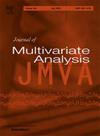Posterior contraction and uncertainty quantification for the multivariate spike-and-slab LASSO
IF 1.4
3区 数学
Q2 STATISTICS & PROBABILITY
引用次数: 0
Abstract
We study the asymptotic properties of Deshpande et al. (2019)’s multivariate spike-and-slab LASSO (mSSL) procedure for simultaneous variable and covariance selection in the sparse multivariate linear regression problem. In that problem, correlated responses are regressed onto covariates and the mSSL works by placing separate spike-and-slab priors on the entries in the matrix of marginal covariate effects and off-diagonal elements in the upper triangle of the residual precision matrix. Under mild assumptions about these matrices, we establish the posterior contraction rate for the mSSL posterior in the asymptotic regime where both and diverge with By “de-biasing” the corresponding MAP estimates, we obtain confidence intervals for each covariate effect and residual partial correlation. In extensive simulation studies, these intervals displayed close-to-nominal frequentist coverage in finite sample settings but tended to be substantially longer than those obtained using a version of the Bayesian bootstrap that randomly re-weights the prior. We further show that the de-biased intervals for individual covariate effects are asymptotically valid.
多变量刺板LASSO的后验收缩和不确定性量化
我们研究了Deshpande等人(2019)在稀疏多元线性回归问题中同时选择变量和协方差的多元spike-and-slab LASSO (mSSL)过程的渐近性质。在该问题中,q个相关响应回归到p个协变量,mSSL通过在边际协变量效应矩阵中的条目和残差精度矩阵上三角形的非对角线元素上放置单独的spike-and-slab先验来工作。在这些矩阵的温和假设下,我们在p和q都随n发散的渐近区域建立了mSSL后验的后验收缩率。通过“去偏置”相应的MAP估计,我们获得了每个协变量效应和残差偏相关的置信区间。在广泛的模拟研究中,这些区间在有限样本设置中显示接近名义频率覆盖,但往往比使用随机重新加权先验的贝叶斯bootstrap版本获得的时间长得多。我们进一步证明了个体协变量效应的去偏区间是渐近有效的。
本文章由计算机程序翻译,如有差异,请以英文原文为准。
求助全文
约1分钟内获得全文
求助全文
来源期刊

Journal of Multivariate Analysis
数学-统计学与概率论
CiteScore
2.40
自引率
25.00%
发文量
108
审稿时长
74 days
期刊介绍:
Founded in 1971, the Journal of Multivariate Analysis (JMVA) is the central venue for the publication of new, relevant methodology and particularly innovative applications pertaining to the analysis and interpretation of multidimensional data.
The journal welcomes contributions to all aspects of multivariate data analysis and modeling, including cluster analysis, discriminant analysis, factor analysis, and multidimensional continuous or discrete distribution theory. Topics of current interest include, but are not limited to, inferential aspects of
Copula modeling
Functional data analysis
Graphical modeling
High-dimensional data analysis
Image analysis
Multivariate extreme-value theory
Sparse modeling
Spatial statistics.
 求助内容:
求助内容: 应助结果提醒方式:
应助结果提醒方式:


